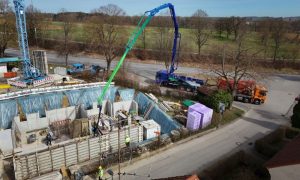BIM powering India’s Western Dedicated Freight Corridor project
BIM is proving vital as work of the second phase of India’s Western Dedicated Freight Corridor continues.
The project is expected to meet the growing demand for freight services in the states of Haryana, Rajasthan, and Uttar Pradesh, says Larsen & Toubro Limited (L&T) is constructing Package CTP-14, a 128-kilometer corridor between Rewari to Dadri passing through the regions of Rewari-Alwar-Mewat-Gurgaon-Palwal-Faridabad-GB Nagar.
According to the firm the project has turned to Bentley’s BIM software to design a route that will reduce the unit cost of transportation and quadruple the current average freight speed from 20 kilometers an hour, as well as introducing time tabled freight services and tripling container capacity from 5,000 to 15,000 tons.
“Since the adoption of BIM methodologies in rail in India is still in its infancy, and in light of significant increases in government expenditure in infrastructure, L&T realised its success on the project could be a game changer. Using a multidiscipline portfolio of Bentley applications, L&T was able to conceptualize, design, and construct the project in a timely manner, leveraging BIM methodologies to share information across the different disciplines involved in the design, delivery, and maintenance of physical assets along the railway,” explained the firm in a report.
L&T added that it has faced environmental and technical challenges, such as difficult and inaccessible terrain, ground stability concerns in areas of deep cut and high embankments, and difficulties in optimising horizontal and vertical alignments to reduce earthworks.
In a critical section laying within a sensitive ecological zone of the Aravalli Hills in the northern part of India, the route crosses terrain requiring a vertical alignment with a maximum cut depth of 25 to 30 meters, plus a viaduct and tunnel, L&T said, adding it was able to explore two route options using OpenRail ConceptStation and leveraged reality modeling with ContextCapture. The latter solution used drone surveys to gain a comprehensive appreciation of the surrounding terrain and infrastructure and to visualise the potential challenges it could encounter during construction.
“As detail design progressed, the dynamic interface of OpenRail Designer allowed team members to compare different scenarios to help simplify logistics, reduce cost, and create a safe environment for site personnel during construction. While asset tagging in OpenBuildings Designer afforded the team a smooth and consistent interface between design and site operations, LumenRT ensured the integration of lifelike animations. These animations helped personnel with non-engineering backgrounds to understand the scope of works and how the project might impact them.”
“At all times and throughout the different stages of the project, Bentley applications helped L&T to reduce costs and optimize its resources – machinery, materials, and manpower – as well as provide a better understanding to stakeholders and achieve greater client satisfaction.”
Nikhil Jose, assistant engineering manager-civil with L&T concluded: “Bentley software helped L&T achieve its vision of digitalisation and implementation of BIM to enable designers, planners, and implementers to use a single repository for the free flow of accurate information and a collaborative way of working through the process of designing, delivering, and maintaining physical assets.”





















